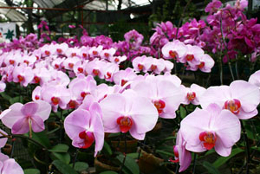The Orchidaceae or orchid family is the largest among all flowering plants. The plant is capable of reblooming, if proper care is taken. The following Buzzle article deals with the steps to be taken for orchid care after flowering.

The orchids are among the most beautiful flowers found on earth. If proper and timely care is taken, one can grow healthy orchids that are able of producing flowers even after the first bloom is over.
After the Flowers Fall Off
The orchid care as a new or young saplings or after flowering is more or less the same. In case of reblooming, taking care of orchids during the dormancy period is of utmost importance. The flowering seasons differ with different varieties; thus, the periods can be classified into sporadic and basic ones. The basic flowering times for the Zygopetalum and Odontoglossum varieties are the months from November to February and February to May, respectively. The Phalaenopsis variety produces flowers throughout the year.
The most common commercial varieties of orchids used in gardening at home are the Phalaenopsis, Odontoglossum, and Zygopetalum. Instructions presented below should be helpful in the process of inducing the secondary blooms.
Inducing Secondary Bloom
To begin with, the spent stalk should be cut with a sterile and sharp tool at a distance of about one-inch from the base. Cutting the stalk almost near the base is looked upon by many as a mistake; however, if the stalk is cut halfway through its length, the quality of the next bloom or secondary flowers would suffer. In fact, the chances of inducing the second bloom reduces by 60% with this approach. The next step in the process is to take the orchid plant out of the pot and examine the root system. The root system, which is the entry point of water and nutrients to the rest of the plant body should be in a healthy condition. The problems such as floppy leaves and shortened buds could crop up, if one tries to go with a root system that is unhealthy. Black or brown mushy roots should be removed. The roots with white, green, or off-white color is a sign of a healthy root system.
Repotting
The medium used for repotting the spent stalk should provide the plant proper ventilation and also help in retaining moisture. One should decide on the size of the pot, taking into account the expanse of the root system and not the leaves. Use of ceramic pots is the best option for providing the plant with the necessary drainage since, these pots have holes on their sides. The pot needs to have enough holes in order to facilitate drainage. If possible, one can add Styrofoam peanuts to the soil for improving the drainage. The stalk should be planted at the center and the medium pressed firmly in order to anchor the plant properly.
Basic Care Tips
Once the plant is repotted, care should be taken to provide water regularly and to allow the growth in ample light.
- Water the plants on a weekly basis and feed it once a month with liquid houseplant fertilizer which is diluted to half strength.
- In order to promote flowering, the plant should be receive bright, indirect light. But make sure the temperature doesn't exceed 75°F.
- The option of hanging the pots from tree branches serve the purpose of providing the plants with filtered sunlight as well as the humidity required during the dormancy phase.
- The orchid stalk in this dormancy phase stores up energy for the next bloom.
- The spikes need to be removed immediately from the plant. It helps in promoting the growth of secondary spikes, which are responsible for new outgrowths of flowers.
If repotting is carried out properly and required temperature & humidity is maintained, it is possible to get a healthy second bloom of orchid.






 The orchids are among the most beautiful flowers found on earth. If proper and timely care is taken, one can grow healthy orchids that are able of producing flowers even after the first bloom is over.
The orchids are among the most beautiful flowers found on earth. If proper and timely care is taken, one can grow healthy orchids that are able of producing flowers even after the first bloom is over.